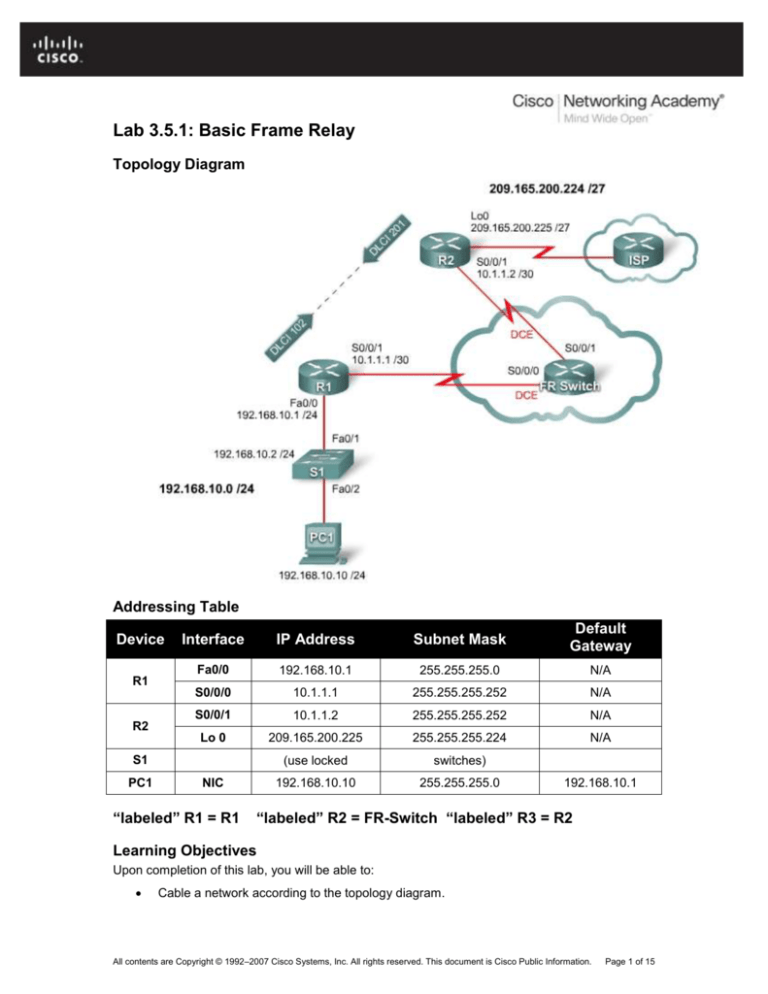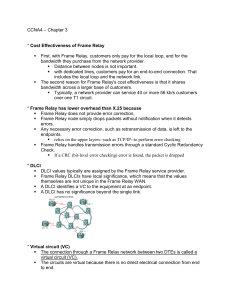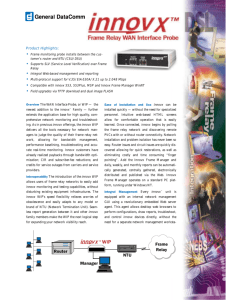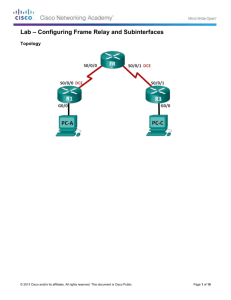
Lab 3.5.1: Basic Frame Relay
Topology Diagram
Addressing Table
Device
R1
R2
Interface
IP Address
Subnet Mask
Default
Gateway
Fa0/0
192.168.10.1
255.255.255.0
N/A
S0/0/0
10.1.1.1
255.255.255.252
N/A
S0/0/1
10.1.1.2
255.255.255.252
N/A
Lo 0
209.165.200.225
255.255.255.224
N/A
(use locked
switches)
192.168.10.10
255.255.255.0
S1
PC1
NIC
“labeled” R1 = R1
192.168.10.1
“labeled” R2 = FR-Switch “labeled” R3 = R2
Learning Objectives
Upon completion of this lab, you will be able to:
Cable a network according to the topology diagram.
All contents are Copyright © 1992–2007 Cisco Systems, Inc. All rights reserved. This document is Cisco Public Information.
Page 1 of 15
CCNA Exploration
Accessing the WAN: Frame Relay
Lab 3.5.1 Basic Frame Relay
Erase the startup configuration and reload a router to the default state.
Perform basic configuration tasks on a router.
Configure and activate interfaces.
Configure EIGRP routing on all routers.
Configure Frame Relay encapsulation on all serial interfaces.
Configure a router as a Frame Relay switch.
Understand the output of the show frame-relay commands.
Learn the effects of the debug frame-relay lmi command.
Intentionally break and restore a Frame Relay link.
Change the Frame Relay encapsulation type from the Cisco default to IETF.
Change the Frame Relay LMI type from Cisco to ANSI.
Configure a Frame Relay subinterface.
Scenario
In this lab, you will learn how to configure Frame Relay encapsulation on serial links using the
network shown in the topology diagram. You will also learn how to configure a router as a Frame
Relay switch. There are both Cisco standards and Open standards that apply to Frame Relay.
You will learn both. Pay special attention in the lab section in which you intentionally break the
Frame Relay configurations. This will help you in the Troubleshooting lab associated with this
chapter.
Task 1: Prepare the Network
Step 1: Cable a network that is similar to the one in the topology diagram.
You can use any current router in your lab as long as it has the required interfaces shown in the
topology. The Frame Relay labs, unlike any of the other labs in Exploration 4, have two DCE
links on the same router. Be sure to change your cabling to reflect the topology diagram.
Note: If you use 1700, 2500, or 2600 routers, the router output and interface descriptions appear
differently.
Step 2: Clear any existing configurations on the routers.
Task 2: Perform Basic Router Configuration
Configure the R1 and R2 routers and the S1 switch according to the following guidelines:
Configure the router hostname.
Disable DNS lookup.
Configure an EXEC mode password.
Configure a message-of-the-day banner.
Configure a password for console connections.
Configure a password for vty connections.
Configure IP addresses on R1 and R2
Important: Leave serial interfaces shut down.
Enable EIGRP AS 1 on R1 and R2 for all networks.
All contents are Copyright © 1992–2007 Cisco Systems, Inc. All rights reserved. This document is Cisco Public Information.
Page 2 of 15
CCNA Exploration
Accessing the WAN: Frame Relay
Lab 3.5.1 Basic Frame Relay
Basic configurations for all routers
enable
configure terminal
hostname [R1, R2, FR-Switch]
no ip domain-lookup
enable secret class
banner motd ^CUnauthorized access strictly prohibited, violators
will be prosecuted to the full extent of the law^C
!
!
!
line console 0
logging synchronous
password cisco
login
!
line vty 0 4
password cisco
login
end
copy running-config startup-config
Basic configurations for switch
enable
configure terminal
hostname [S1]
no ip domain-lookup
enable secret class
banner motd ^CUnauthorized access strictly prohibited, violators
will be prosecuted to the full extent of the law^C
!
!
!
line console 0
logging synchronous
password cisco
login
!
line vty 0 15
password cisco
login
end
copy running-config startup-config
All contents are Copyright © 1992–2007 Cisco Systems, Inc. All rights reserved. This document is Cisco Public Information.
Page 3 of 15
CCNA Exploration
Accessing the WAN: Frame Relay
Lab 3.5.1 Basic Frame Relay
R1
interface serial 0/0/0
ip address 10.1.1.1 255.255.255.252
shutdown
!The serial interfaces should remain shutdown until the Frame Relay
!switch is configured
interface fastethernet 0/0
ip address 192.168.10.1 255.255.255.0
no shutdown
router eigrp 1
no auto-summary
network 10.0.0.0
network 192.168.10.0
!
R2
interface serial 0/0/1
ip address 10.1.1.2 255.255.255.252
shutdown
!The serial interfaces should remain shutdown until the Frame Relay
!switch is configured
interface loopback 0
ip address 209.165.200.225 255.255.255.224
router eigrp 1
no auto-summary
network 10.0.0.0
network 209.165.200.0
!
Task 3: Configure Frame Relay
You will now set up a basic point-to-point Frame Relay connection between routers 1 and 2. You
first need to configure FR Switch as a Frame Relay switch and create DLCIs.
What does DLCI stand for?
_________________________________________________________________________
What is a DLCI used for?
_____________________________________________________________________________
_____________________________________________________________________________
What is a PVC and how is it used?
_____________________________________________________________________________
All contents are Copyright © 1992–2007 Cisco Systems, Inc. All rights reserved. This document is Cisco Public Information.
Page 4 of 15
CCNA Exploration
Accessing the WAN: Frame Relay
Lab 3.5.1 Basic Frame Relay
_____________________________________________________________________________
_____________________________________________________________________________
Step 1: Configure FR Switch as a Frame Relay switch and create a PVC between R1 and
R2.
This command enables Frame Relay switching globally on the router, allowing it to forward
frames based on the incoming DLCI rather than on an IP address basis:
FR-Switch(config)#frame-relay switching
Change the interface encapsulation type to Frame Relay. Like HDLC or PPP, Frame Relay is a
data link layer protocol that specifies the framing of Layer 2 traffic.
FR-Switch(config)#interface serial 0/0/0
FR-Switch(config)#clock rate 64000
FR-Switch(config-if)#encapsulation frame-relay
Changing the interface type to DCE tells the router to send LMI keepalives and allows Frame
Relay route statements to be applied. You cannot set up PVCs using the frame-relay route
command between two Frame Relay DTE interfaces.
FR-Switch(config-if)#frame-relay intf-type dce
Note: Frame Relay interface types do not need to match the underlying physical interface type. A
physical DTE serial interface can act as a Frame Relay DCE interface, and a physical DCE
interface can act as a logical Frame Relay DTE interface.
Configure the router to forward incoming traffic on interface serial 0/0/0 with DLCI 102 to serial
0/0/1 with an output DLCI of 201.
FR-Switch(config-if)#frame-relay route 102 interface serial 0/0/1 201
FR-Switch(config-if)#no shutdown
This configuration creates two PVCs: one from R1 to R2 (DLCI 102), and one from R2 to R1
(DLCI 201). You can verify the configuration using the show frame-relay pvc command.
FR-Switch(config-if)#interface serial 0/0/1
FR-Switch(config)#clock rate 64000
FR-Switch(config-if)#encapsulation frame-relay
FR-Switch(config-if)#frame-relay intf-type dce
FR-Switch(config-if)#frame-relay route 201 interface serial 0/0/0 102
FR-Switch(config-if)#no shutdown
FR-Switch#show frame-relay pvc
PVC Statistics for interface Serial0/0/0 (Frame Relay DCE)
Local
Switched
Unused
Active
0
0
0
Inactive
0
1
0
Deleted
0
0
0
Static
0
0
0
DLCI = 102, DLCI USAGE = SWITCHED, PVC STATUS = INACTIVE, INTERFACE =
Serial0/0/0
input pkts 0
output pkts 0
in bytes 0
All contents are Copyright © 1992–2007 Cisco Systems, Inc. All rights reserved. This document is Cisco Public Information.
Page 5 of 15
CCNA Exploration
Accessing the WAN: Frame Relay
Lab 3.5.1 Basic Frame Relay
out bytes 0
dropped pkts 0
in pkts dropped 0
out pkts dropped 0
out bytes dropped 0
in FECN pkts 0
in BECN pkts 0
out FECN pkts 0
out BECN pkts 0
in DE pkts 0
out DE pkts 0
out bcast pkts 0
out bcast bytes 0
30 second input rate 0 bits/sec, 0 packets/sec
30 second output rate 0 bits/sec, 0 packets/sec
switched pkts 0
Detailed packet drop counters:
no out intf 0
out intf down 0
no out PVC 0
in PVC down 0
out PVC down 0
pkt too big 0
shaping Q full 0
pkt above DE 0
policing drop 0
pvc create time 00:03:33, last time pvc status changed 00:00:19
PVC Statistics for interface Serial0/0/1 (Frame Relay DCE)
Local
Switched
Unused
Active
0
0
0
Inactive
0
1
0
Deleted
0
0
0
Static
0
0
0
DLCI = 201, DLCI USAGE = SWITCHED, PVC STATUS = INACTIVE, INTERFACE =
Serial0/0/1
input pkts 0
output pkts 0
in bytes 0
out bytes 0
dropped pkts 0
in pkts dropped 0
out pkts dropped 0
out bytes dropped 0
in FECN pkts 0
in BECN pkts 0
out FECN pkts 0
out BECN pkts 0
in DE pkts 0
out DE pkts 0
out bcast pkts 0
out bcast bytes 0
30 second input rate 0 bits/sec, 0 packets/sec
30 second output rate 0 bits/sec, 0 packets/sec
switched pkts 0
Detailed packet drop counters:
no out intf 0
out intf down 0
no out PVC 0
in PVC down 0
out PVC down 0
pkt too big 0
shaping Q full 0
pkt above DE 0
policing drop 0
pvc create time 00:02:02, last time pvc status changed 00:00:18
Notice the 1 in the Inactive column. The PVC you have created does not have any endpoints
configured. The Frame Relay switch knows this and has marked the PVC as Inactive.
Issue the show frame-relay route command. This command shows any existing Frame Relay
routes, their interfaces, DLCIs, and status. This is the Layer 2 route that Frame Relay traffic takes
through the network. Do not confuse this with Layer 3 IP routing.
FR-Switch#show frame-relay route
Input Intf
Serial0/0/0
Serial0/0/1
Input Dlci
102
201
Output Intf
Serial0/0/1
Serial0/0/0
Output Dlci
201
102
Status
inactive
inactive
Step 2: Configure R1 for Frame Relay.
Inverse ARP allows distant ends of a Frame Relay link to dynamically discover each other and
provides a dynamic method of mapping IP addresses to DLCIs. Although Inverse ARP is useful, it
All contents are Copyright © 1992–2007 Cisco Systems, Inc. All rights reserved. This document is Cisco Public Information.
Page 6 of 15
CCNA Exploration
Accessing the WAN: Frame Relay
Lab 3.5.1 Basic Frame Relay
is not always reliable. The best practice is to statically map IP addresses to DLCIs and to disable
inverse-arp.
R1(config)#interface serial 0/0/1
R1(config-if)#encapsulation frame-relay
R1(config-if)#no frame-relay inverse-arp
Why would you want to map an IP address to a DLCI?
_____________________________________________________________________________
_____________________________________________________________________________
_____________________________________________________________________________
_____________________________________________________________________________
The command frame-relay map statically maps an IP address to a DLCI. In addition to mapping
IP to a DLCI, Cisco IOS software allows several other Layer 3 protocol addresses to be mapped.
The broadcast keyword in the following command sends any multicast or broadcast traffic
destined for this link over the DLCI. Most routing protocols require the broadcast keyword to
properly function over Frame Relay. You can use the broadcast keyword on multiple DLCIs on
the same interface. The traffic is replicated to all PVCs.
R1(config-if)#frame-relay map ip 10.1.1.2 102 broadcast
In order for the router to be able to ping its own interface, a second map must be created to map
the DLCI to the local interface.
R1(config-if)#frame-relay map ip 10.1.1.1 102
Is the DLCI mapped to the local IP address or the IP address at the other end of the PVC?
_____________________________________________________________________________
R1(config-if)#no shutdown
Why is the no shutdown command used after the no frame-relay inverse-arp command?
_________________________________________________________________________
_________________________________________________________________________
_________________________________________________________________________
_________________________________________________________________________
Step 3: Configure R2 for Frame Relay.
R2(config)#interface serial 0/0/1
R2(config-if)#encapsulation frame-relay
All contents are Copyright © 1992–2007 Cisco Systems, Inc. All rights reserved. This document is Cisco Public Information.
Page 7 of 15
CCNA Exploration
Accessing the WAN: Frame Relay
Lab 3.5.1 Basic Frame Relay
R2(config-if)#no frame-relay inverse-arp
R2(config-if)#frame-relay map ip 10.1.1.1 201 broadcast
In order for the router to be able to ping its own interface, a second map must be created to map
the DLCI to the local interface.
R2(config-if)#frame-relay map ip 10.1.1.2 201
R2(config-if)#no shutdown
At this point, you receive messages indicating that the interfaces have come up and that EIGRP
neighbor adjacency has been established.
R1#*Sep 9 17:05:08.771: %DUAL-5-NBRCHANGE: IP-EIGRP(0) 1: Neighbor
10.1.1.2 (Serial0/0/1) is up: new adjacency
R2#*Sep 9 17:05:47.691: %DUAL-5-NBRCHANGE: IP-EIGRP(0) 1: Neighbor
10.1.1.1 (Serial0/0/1) is up: new adjacency
The show ip route command shows complete routing tables.
R1:
R1#show ip route
Codes: C - connected, S - static, R - RIP, M - mobile, B - BGP
D - EIGRP, EX - EIGRP external, O - OSPF, IA - OSPF inter area
N1 - OSPF NSSA external type 1, N2 - OSPF NSSA external type 2
E1 - OSPF external type 1, E2 - OSPF external type 2
i - IS-IS, su - IS-IS summary, L1 - IS-IS level-1, L2 - IS-IS
level-2
ia - IS-IS inter area, * - candidate default, U - per-user
static
route
o - ODR, P - periodic downloaded static route
Gateway of last resort is not set
C
D
C
192.168.10.0/24 is directly connected, FastEthernet0/0
209.165.200.0/24 [90/20640000] via 10.1.1.2, 00:00:07, Serial0/0/1
10.0.0.0/30 is subnetted, 1 subnets
10.1.1.0 is directly connected, Serial0/0/1
R2:
R2#show ip route
Codes: C - connected, S - static, R - RIP, M - mobile, B - BGP
D - EIGRP, EX - EIGRP external, O - OSPF, IA - OSPF inter area
N1 - OSPF NSSA external type 1, N2 - OSPF NSSA external type 2
E1 - OSPF external type 1, E2 - OSPF external type 2
i - IS-IS, su - IS-IS summary, L1 - IS-IS level-1, L2 - IS-IS level2
ia - IS-IS inter area, * - candidate default, U - per-user static
route
o - ODR, P - periodic downloaded static route
Gateway of last resort is not set
D
192.168.10.0/24 [90/20514560] via 10.1.1.1, 00:26:03, Serial0/0/1
All contents are Copyright © 1992–2007 Cisco Systems, Inc. All rights reserved. This document is Cisco Public Information.
Page 8 of 15
CCNA Exploration
Accessing the WAN: Frame Relay
Lab 3.5.1 Basic Frame Relay
209.165.200.0/27 is subnetted, 1 subnets
209.165.200.224 is directly connected, Loopback0
10.0.0.0/30 is subnetted, 1 subnets
10.1.1.0 is directly connected, Serial0/0/1
C
C
Task 4: Verify the Configuration
You should now be able to ping from R1 to R2. It may take several seconds after bringing up the
interfaces for the PVC to become active. You can also see EIGRP routes for each router.
Step 1: Ping R1 and R2.
Ensure that you can ping router R2 from router R1.
R1#ping 10.1.1.2
Type escape sequence to abort.
Sending 5, 100-byte ICMP Echos to 10.1.1.2, timeout is 2 seconds:
!!!!!
Success rate is 100 percent (5/5), round-trip min/avg/max = 28/29/32
ms
R2#ping 10.1.1.1
Type escape sequence to abort.
Sending 5, 100-byte ICMP Echos to 10.1.1.1, timeout is 2 seconds:
!!!!!
Success rate is 100 percent (5/5), round-trip min/avg/max = 28/29/32
ms
Step 2: Get PVC information.
The show frame-relay pvc command displays information on all PVCs configured on the router.
The output also includes the associated DLCI.
R1:
R1#show frame-relay pvc
PVC Statistics for interface Serial0/0/1 (Frame Relay DTE)
Local
Switched
Unused
Active
1
0
0
Inactive
0
0
0
Deleted
0
0
0
Static
0
0
0
DLCI = 102, DLCI USAGE = LOCAL, PVC STATUS = ACTIVE, INTERFACE =
Serial0/0/1
input pkts 5
output pkts 5
in bytes 520
out bytes 520
dropped pkts 0
in pkts dropped 0
out pkts dropped 0
out bytes dropped 0
in FECN pkts 0
in BECN pkts 0
out FECN pkts 0
out BECN pkts 0
in DE pkts 0
out DE pkts 0
out bcast pkts 0
out bcast bytes 0
5 minute input rate 0 bits/sec, 0 packets/sec
5 minute output rate 0 bits/sec, 0 packets/sec
pvc create time 10:26:41, last time pvc status changed 00:01:04
All contents are Copyright © 1992–2007 Cisco Systems, Inc. All rights reserved. This document is Cisco Public Information.
Page 9 of 15
CCNA Exploration
Accessing the WAN: Frame Relay
Lab 3.5.1 Basic Frame Relay
R2:
R2#show frame-relay pvc
PVC Statistics for interface Serial0/0/1 (Frame Relay DTE)
Local
Switched
Unused
Active
1
0
0
Inactive
0
0
0
Deleted
0
0
0
Static
0
0
0
DLCI = 201, DLCI USAGE = LOCAL, PVC STATUS = ACTIVE, INTERFACE =
Serial0/0/1
input pkts 5
output pkts 5
in bytes 520
out bytes 520
dropped pkts 0
in pkts dropped 0
out pkts dropped 0
out bytes dropped 0
in FECN pkts 0
in BECN pkts 0
out FECN pkts 0
out BECN pkts 0
in DE pkts 0
out DE pkts 0
out bcast pkts 0
out bcast bytes 0
5 minute input rate 0 bits/sec, 0 packets/sec
5 minute output rate 0 bits/sec, 0 packets/sec
pvc create time 10:25:31, last time pvc status changed 00:00:00
FR Switch:
FR-Switch#show frame-relay pvc
PVC Statistics for interface Serial0/0/0 (Frame Relay DCE)
Local
Switched
Unused
Active
0
1
0
Inactive
0
0
0
Deleted
0
0
0
Static
0
0
0
DLCI = 102, DLCI USAGE = SWITCHED, PVC STATUS = ACTIVE, INTERFACE =
Serial0/0/0
input pkts 0
output pkts 0
in bytes 0
out bytes 0
dropped pkts 0
in pkts dropped 0
out pkts dropped 0
out bytes dropped 0
in FECN pkts 0
in BECN pkts 0
out FECN pkts 0
out BECN pkts 0
in DE pkts 0
out DE pkts 0
out bcast pkts 0
out bcast bytes 0
30 second input rate 0 bits/sec, 0 packets/sec
30 second output rate 0 bits/sec, 0 packets/sec
switched pkts 0
Detailed packet drop counters:
no out intf 0
out intf down 0
no out PVC 0
in PVC down 0
out PVC down 0
pkt too big 0
shaping Q full 0
pkt above DE 0
policing drop 0
pvc create time 10:28:31, last time pvc status changed 00:03:57
PVC Statistics for interface Serial0/0/1 (Frame Relay DCE)
Active
Inactive
Deleted
Static
All contents are Copyright © 1992–2007 Cisco Systems, Inc. All rights reserved. This document is Cisco Public Information.
Page 10 of 15
CCNA Exploration
Accessing the WAN: Frame Relay
Local
Switched
Unused
0
1
0
Lab 3.5.1 Basic Frame Relay
0
0
0
0
0
0
0
0
0
DLCI = 201, DLCI USAGE = SWITCHED, PVC STATUS = ACTIVE, INTERFACE =
Serial0/0/1
input pkts 0
output pkts 0
in bytes 0
out bytes 0
dropped pkts 0
in pkts dropped 0
out pkts dropped 0
out bytes dropped 0
in FECN pkts 0
in BECN pkts 0
out FECN pkts 0
out BECN pkts 0
in DE pkts 0
out DE pkts 0
out bcast pkts 0
out bcast bytes 0
30 second input rate 0 bits/sec, 0 packets/sec
30 second output rate 0 bits/sec, 0 packets/sec
switched pkts 0
Detailed packet drop counters:
no out intf 0
out intf down 0
no out PVC 0
in PVC down 0
out PVC down 0
pkt too big 0
shaping Q full 0
pkt above DE 0
policing drop 0
pvc create time 10:27:00, last time pvc status changed 00:04:03
Step 3: Verify Frame Relay mappings.
The show frame-relay map command displays information on the static and dynamic mappings
of Layer 3 addresses to DLCIs. Because Inverse ARP has been turned off, there are only static
maps.
R1:
R1#show frame-relay map
Serial0/0/1 (up): ip 10.1.1.2 dlci 102(0x66,0x1860), static, broadcast,
CISCO, status defined, active
R2:
R2#show frame-relay map
Serial0/0/1 (up): ip 10.1.1.1 dlci 201(0xC9,0x3090), static, broadcast,
CISCO, status defined, active
FR Switch:
FR Switch acts as a Layer 2 device, so there is no need to map Layer 3 addresses to Layer 2
DLCIs.
Step 4: Debug the Frame Relay LMI.
What purpose does the LMI serve in a Frame Relay network?
_____________________________________________________________________________
_____________________________________________________________________________
_____________________________________________________________________________
_____________________________________________________________________________
All contents are Copyright © 1992–2007 Cisco Systems, Inc. All rights reserved. This document is Cisco Public Information.
Page 11 of 15
CCNA Exploration
Accessing the WAN: Frame Relay
Lab 3.5.1 Basic Frame Relay
What are the three different types of LMI?
_____________________________________________________________________________
What DLCI does the Cisco LMI operate on?
_____________________________________________________________________________
Issue the debug frame-relay lmi command. The output gives detailed information on all LMI
data. Keepalives are sent every 10 seconds, so you may have to wait until you see any output.
The debug output shows two LMI packets: the first outgoing, the second incoming.
R1#debug frame-relay lmi
Frame Relay LMI debugging is on
Displaying all Frame Relay LMI data
R1#
*Aug 24 06:19:15.920: Serial0/0/1(out): StEnq, myseq 196, yourseen
195, DTE up
*Aug 24 06:19:15.920: datagramstart = 0xE73F24F4, datagramsize = 13
*Aug 24 06:19:15.920: FR encap = 0xFCF10309
*Aug 24 06:19:15.920: 00 75 01 01 00 03 02 C4 C3
*Aug 24 06:19:15.920:
*Aug 24 06:19:15.924: Serial0/0/1(in): Status, myseq 196, pak size 21
*Aug 24 06:19:15.924: RT IE 1, length 1, type 0
*Aug 24 06:19:15.924: KA IE 3, length 2, yourseq 196, myseq 196
*Aug 24 06:19:15.924: PVC IE 0x7 , length 0x6 , dlci 102, status 0x2
, bw 0
R1#undebug all
Port Statistics for unclassified packets is not turned on.
All possible debugging has been turned off
Notice that the output shows an outgoing LMI packet with a sequence number of 196. The last
LMI message received from the FR Switch had sequence number 195.
*Aug 24 06:19:15.920: Serial0/0/1(out): StEnq, myseq 196, yourseen
195, DTE up
This line indicates an incoming LMI message from the FR Switch to R1 with sequence number
196.
*Aug 24 06:19:15.924: Serial0/0/1(in): Status, myseq 196, pak size 21
FR Switch sent this as sequence number 196 (myseq), and the last LMI message received by the
FR-Switch from R1 had sequence number 196 (yourseq).
*Aug 24 06:19:15.924: KA IE 3, length 2, yourseq 196, myseq 196
DLCI 102 is the only DLCI on this link, and it is currently active.
*Aug 24 06:19:15.924: PVC IE 0x7 , length 0x6 , dlci 102, status 0x2
, bw 0
All contents are Copyright © 1992–2007 Cisco Systems, Inc. All rights reserved. This document is Cisco Public Information.
Page 12 of 15
CCNA Exploration
Accessing the WAN: Frame Relay
Lab 3.5.1 Basic Frame Relay
Final Configurations
R1#show run
<output omitted>
!
hostname R1
enable secret class
no ip domain lookup
!
interface FastEthernet0/0
ip address 192.168.10.1 255.255.255.0
no shutdown
!
interface Serial0/0/0
clock rate 64000
ip address 10.1.1.1 255.255.255.252
encapsulation frame-relay
frame-relay map ip 10.1.1.2 102 broadcast
no frame-relay inverse-arp
no shutdown
!
!
router eigrp 1
network 10.0.0.0
network 192.168.10.0
no auto-summary
!
!
banner motd ^CUnauthorized access prohibited, violators will be
prosecuted to the full extent of the law.^C
!
line con 0
password cisco
logging synchronous
login
line aux 0
line vty 0 4
login
password cisco
!
end
R2#show run
<output omitted>
!
hostname R2
!
!
enable secret class
!
!
no ip domain lookup
!
!
All contents are Copyright © 1992–2007 Cisco Systems, Inc. All rights reserved. This document is Cisco Public Information.
Page 13 of 15
CCNA Exploration
Accessing the WAN: Frame Relay
Lab 3.5.1 Basic Frame Relay
interface Loopback0
ip address 209.165.200.225 255.255.255.224
!
!
interface Serial0/0/1
ip address 10.1.1.2 255.255.255.252
encapsulation frame-relay
frame-relay map ip 10.1.1.1 201 broadcast
no frame-relay inverse-arp
frame-relay lmi-type cisco
no shutdown
!
router eigrp 1
network 10.0.0.0
network 209.165.200.0
no auto-summary
!
!
line con 0
password cisco
logging synchronous
login
line aux 0
line vty 0 4
password cisco
login
!
end
FR-Switch#show run
<output omitted>
!
hostname FR-Switch
!
enable secret class
!
no ip domain lookup
frame-relay switching
!
!
!
!
interface Serial0/0/0
no ip address
encapsulation frame-relay
clockrate 64000
frame-relay intf-type dce
frame-relay route 102 interface Serial0/0/1 201
frame-relay route 112 interface Serial0/0/1 212
no shutdown
!
interface Serial0/0/1
no ip address
encapsulation frame-relay
clock rate 64000
frame-relay intf-type dce
All contents are Copyright © 1992–2007 Cisco Systems, Inc. All rights reserved. This document is Cisco Public Information.
Page 14 of 15
CCNA Exploration
Accessing the WAN: Frame Relay
Lab 3.5.1 Basic Frame Relay
frame-relay route 201 interface Serial0/0/0 102
frame-relay route 212 interface Serial0/0/0 112
no shutdown
!
!
line con 0
password cisco
login
line aux 0
line vty 0 4
password cisco
login
!
end
All contents are Copyright © 1992–2007 Cisco Systems, Inc. All rights reserved. This document is Cisco Public Information.
Page 15 of 15










